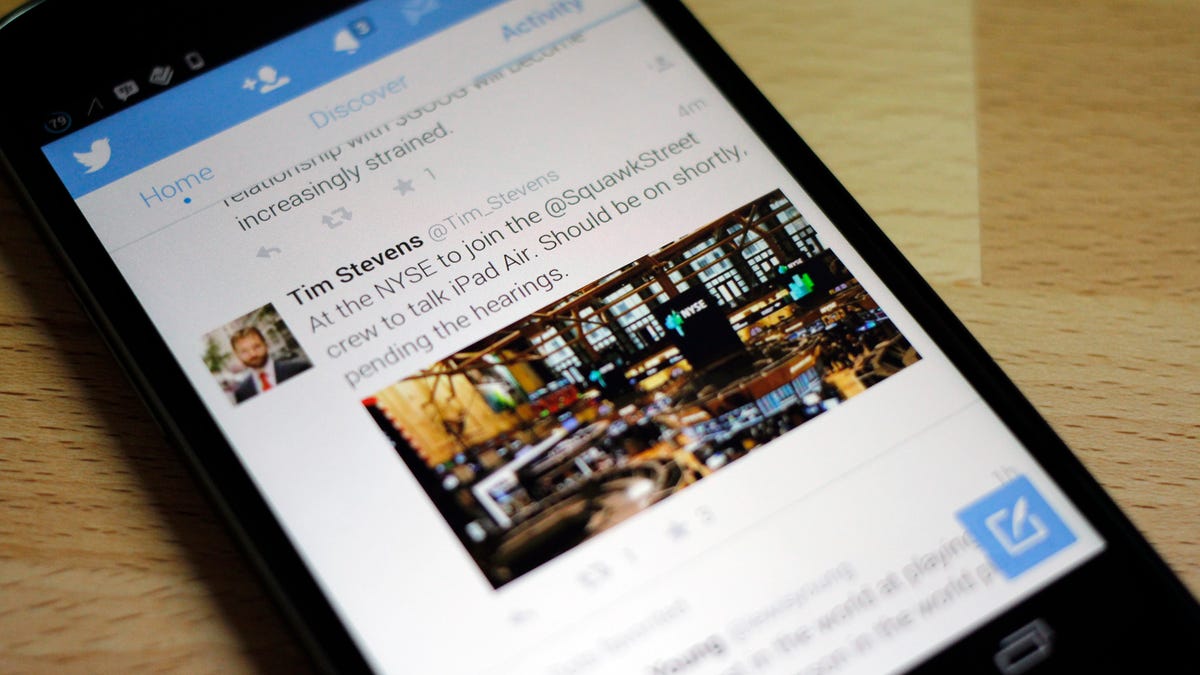Boobs and banner ads: Twitter's Facebook dilemma
Welcome or otherwise, image and video previews in tweets highlight the company's tension between building a service that people love and pleasing Wall Street.

Thanks to a recent change in how Twitter displays photos and videos, scanning your tweet feed on a desktop or mobile device is either an eye-popping or infuriating experience.
Earlier last week -- just days before Twitter will price shares for its initial public offering -- the social network known for 140-character missives altered its text-based format to emphasize visual media.
Once a click away, Twitter photos and Vine videos are being thrust into the faces of the company's 230 million members. The change means that photos or videos uploaded to Twitter's services are included inside tweets as they flow through your timeline. Previously, the same rich media content was obscured from view in the main feed. Twitter, for the first time, now closely resembles another popular social network: Facebook.
"The reality here is that Twitter is taking a page from Facebook's repertoire," S&P Capital IQ Equity Analyst Scott Kessler told CNET. "They're saying ... the timeline should be more media-friendly, more interactive, and more appealing to the senses."
It's the irony of all ironies as Facebook has, in recent months, copied with unproven results the core tenets of Twitter to more closely link its social network to breaking news and current events.
The implications of Twitter's Facebook pivot are far-reaching. The company is far from knocking on the door of profitability. Twitter lost $132 million on a $422 million in revenue during the first nine months of the year. Clearly, it has a few problems to solve before it gets in the black, one of them being getting netizens and advertisers to embrace the sometimes confusing network and its uniquely Twitter conventions.
Urgh Twitter ads are more annoying, hard to ignore, w. the larger image embeds
— Evelyn Rusli (@EvelynRusli) October 30, 2013
The familiarity of a stream of photos and videos is certainly one way to go about acclimating people to Twitter and giving advertisers more bang for their buck, but the Facebook-inspired visual additions could alienate the people who have come to appreciate Twitter's individuality. Twitter's new picture-ific structure mirrors Facebook in another not-so flattering way: ads with images are now impossible to avoid.
At their worst, Twitter ads now resemble banner ads. Yet instead of being relegated to the right-hand side of a Web page, the ads are popping up in the stream on desktop and mobile. The brand-appeal, however, is that a company can pay to promote a tweet to a wider audience and use the power of an in-line photograph to make a stronger impact. Take Victoria's Secret, for instance, which recently ran a Promoted Tweet with an image of a scantily clad model whose boobs, which would have previously been hidden from view until a person clicked to view them, ran through the timelines of a wide-eyed audience.
"This is a perfect example of an ad that could be either very welcome, or most unwelcome," Rebecca Lieb, media analyst for Altimeter Group, said. "It's not just the large, intrusive format, but also the subject matter which veers into uncomfortable territory for users who might not welcome the ad on their work computers."
The ad won't be the last to make its way uninvited to members' timelines as Twitter attempts to goose revenue. Twitter, which declined to be interviewed for this story, would likely argue that the downside to inescapable visual ads is outweighed by other benefits of putting images in the feed. A continuous cascade of Halloween photos, for instance, turned the network into a more visually enjoyable zone for many users. And if you don't want the additional content, you can always turn the feature off -- well, sort of.
Welcome or otherwise, image and video previews in tweets highlight the tension between building a service that people love and pleasing Wall Street. It's a tension that Facebook is all too familiar with, though the larger social network, which is more than five times the size of Twitter, seems to have found a working balance for the time being.
Also I went from not caring about Twitter ads to being distracted & disturbed by this image-heavy feed. Facebook and Twitter are converging.
— Scott Lewis (@vosdscott) October 31, 2013
Twitter calculates the value of its service by measuring advertising revenue per 1,000 timeline views. For a company that is losing money and has noticed a slowed growth in active members, it's even more troubling that total timeline views per user appear to be on the decline.
"Growth in timeline views has decelerated notably on a sequential basis in 2013, from 92 percent in the first quarter, to 69 percent in the second quarter, to 50 percent in the third quarter," Kessler wrote in his pre-IPO note on Twitter. "Also, noteworthy, we think, sequential growth in timeline views per user decelerated in the second and third quarters of 2012 and actually declined in the third quarter of 2013."
One way to boost timeline views is to make Twitter's stream more enthralling to more people, which seems to be the point of in-line images and Vine videos. Kessler said it makes perfect sense for Twitter to go after more universal appeal, even if that means emulating Facebook and risking fallout from obnoxious ads.
The possible benefits far outweigh the concerns, he said. "Facebook has been doing this for years ... at this point with relatively significant success."
Twitter users and advertisers will ultimately have the last word, of course. If the company gets its way, those words will take the form of photos and videos.

